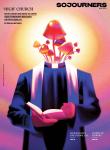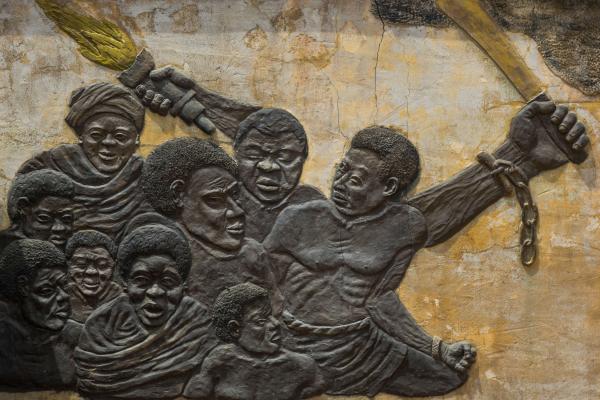Nazia Kazi knows her history well: A Ph.D. in anthropology, she teaches courses on race, ethnicity, immigration, and Islam in the U.S. at Stockton University in Philadelphia. Kazi’s new book, Islamophobia, Race, and Global Politics, released Dec. 12 from Rowman & Littlefield, discusses the scope of Islamophobia in the U.S. from the country’s historical and political roots. Drawing on examples such as the legacy of Barack Obama, the mainstream media’s portrayal of Muslims, and the justifications given for some of America’s most recent military endeavors, Kazi highlights the vast impact of Islamophobia, connecting this to a long history of U.S. racism.
Sojourners sat down with Kazi to discuss what her book can tell us about the New Zealand shootings, what they and the Trump administration tell us about historic and current Islamophobia, and the community organizations that are active in dismantling xenophobia to create just representation for Muslim and migrant communities.
Ariel Parrella-Aureli, for Sojourners: What do the New Zealand shootings say about global Islamophobia?
Nazia Kazi: What happened in New Zealand, the shooter was inspired by the Great Replacement Theory, which came from France but has spread across the West. Basically, it’s this panic that the white race is quickly being replaced by black, brown, and migrant people. The great replacement is not some weird, fringe conspiracy; it’s become quite mainstream. Even in the U.S., we have seen people who are panicking about “white genocide,” which is a myth, but it is also used to bolster this type of xenophobia. Now with someone like Donald Trump in office — and we know there are more guns in the U.S. per capita than anywhere in the world — this type of violence has been given a license that is unprecedented in so many ways.
Parrella-Aureli: In the aftermath of the shooting, do you think Muslims in the U.S. are vulnerable?
Kazi: One of the things we should be really careful of when we are thinking of New Zealand or the Montreal mosque attack or the black church shooting, is that we make a huge mistake when we regard these things as some kind of monstrous, senseless act of violence. In fact, they make perfect sense when you zoom out and look at American history. The black church that Dylan Roof shot up — as soon as that massacre happened, people on CNN were on the news saying, “This is a senseless act of violence, how could this happen now?” The church stood on a street named Calhoun Street, named after John C. Calhoun, one of the most pro-slavery politicians. So, when you think about it in that way, these things start to make perfect sense. New Zealand is a settler colonial society; it is built on stolen Indigenous land. So is Australia — so is [the U.S.]. When that kind of violence is just the backdrop — when Andrew Jackson is on the $20 bill, what do we expect but these types of egregious forms of violence? So, yes, people of color are absolutely vulnerable to this type of violence, but we also need to see it as intimately connected to things that are baked into the apple pie. It’s right there in the flag; it’s stitched into it.
Parrella-Aureli: Do you think the shootings were a wake-up call for the West or have brought to light any important conversations?
Kazi: I think one of the most beautiful things that happened is we saw the Māori standing alongside Muslims and in the U.S. we have yet to see a lot … it exists for sure but the connection between American Islamophobia and American racism as we see it today, and the realities of America as a settler, colonial nation that is anti-Indigenous — that has not gotten a lot of press time. That was one of the beautiful things that happened in the wake of that awful tragedy, you saw Indigenous solidarity with Muslims in a way that was really revealing and drew attention to the fact that what we are talking about here is white supremacy, not a global assault on Muslims; we are talking about the intensification of white supremacy.
Parrella-Aureli: How has Islamophobia fed into U.S. politics now?
Kazi: In the U.S., Islamophobia has fed into anti Latino racism. This whole idea of building a wall, people are like, “that’s stupid,” but then the [government] is like, “But Muslims might sneak across the border, too,” and then everyone wants to do it. Pence and Trump were saying a few weeks ago that the caravan has Middle Easterners in it. Trump tweeted, “Border Patrol is finding prayer rugs in the desert.” So maybe they don’t hate Latin American enough, so we will throw some Arabs in there and then it will be OK. So, all of these things really intersect in interesting ways that people who are trying to fight these forces ought to be aware of. The Department of Homeland Security absorbs immigration and naturalization services reveals that — it’s like, “Oh, we have to protect ourselves from terrorism,” and one of the ways they do that is by cracking down on migrants from Latin America. Islamophobia feeds anti-Latino racism and vice versa. You can say that for any marginalized group facing oppression.
Parrella-Aureli: One of the chapters in your new book, "Beyond Trump," stresses that these issues span past the current administration and are patterns in our political system. Why is it that during the Obama era, when there was a similar narrative of patrolling Muslims through the National Security Entry-Exit Registration System program , the U.S. seemed more on board, but when Trump instated the Muslim travel ban, there was widespread opposition?
Kazi: I talk about that a lot in the chapter, which talks about why we think this moment is so different and more atrocious, and so un-American. But really, when you study American politics, you say of course this is going to happen. There is this great article in the Intercept about how the Obama presidency expanded executive powers and gave the president so much power to do scary things that now Trump has. Why weren’t we scared or interested when it was happening under Obama, right? It was Bill Clinton who authorized building a fence at the U.S.-Mexico border, so why is it when Trump fans are chanting “build the wall” we want to wave protests? There is something really weird about both [how] partisan politics play out in the U.S. and the way we want to acknowledge the threat of someone when they act out on Twitter and don’t blow the dog whistle. Trump doesn’t veil his racism — he straight up says Mexicans are rapists. But when we look at Obama’s record in regards to deportation, but really, are we just giving the rhetorical shift that much weight? That’s an important question.
Parrella-Aureli: Are we at a pinnacle or height surrounding the discussion around Muslims and Islamophobia in the U.S.?
Kazi: History will show, but it does seem there is a cyclical thing happening. We can start in 1492 when Spain was purging Muslims [but] people want to start the conversation about Islamophobia with post-9/11 or 1993 World Trade Center. That ignores the fact that Operation Boulder was spying on Muslims after the Israeli Olympic team members were taken hostage in Munich in 1972, that there was a Muslim ban that affected enslaved Muslims from Africa, that Islamophobia was parceled into Columbus’s legacy, because if Spain was having their inquisition, which was Islamophobic and anti-Semitic to its core, these things have been the backdrop and founding of North America. Of course, 9/11 and the Trump election have been these flashpoints in which things have bubbled to the surface in troubling and visible ways, but there is a long history there.
When Timothy McVeigh bombed an Oklahoma City federal building, no one knew who he was. People were whispering [that] it had to be Muslims. It wasn’t, but regardless, Bill Clinton re-wrote immigration laws in response to a white nationalist bombing Oklahoma City in a way that affected Muslims. There is a deep Islamophobia there.
Parrella-Aureli: What are some groups that focus on social change, activism, and community engagement to dismantle Islamophobia?
Kazi: One of the interesting things is when you try to go work as “Muslims” all of this falls apart because Muslims are fractured along lines of race, class, all of these things. But, Islamophobia still exists and it does not target Muslims the same way across groups. That’s why I think the best anti-Islamophobic organizing is not coming from people who are doing it in the name of “fighting [for] Muslims.” For instance, DRUM: Desis Rising Up and Moving in New York City. Fahd Ahmed is the executive director, and I think they have done so much good work protecting migrants since 9/11 in a way that is truly grassroots, in a way that is truly committed to transformative liberation. In doing so, they are fighting Islamophobia but they are not doing it “to fight Islamophobia,” with that label. The Justice for Muslims Collective in Washington, D.C., also does important work, but again, they are one of the rare ones organizing under the rare term “Muslim” because it is such a tricky and almost problematic category, in ways where it ends up privileging Muslims. The most sheltered from Islamophobia become the ones most to [benefit from it].
Parrella-Aureli: Is that because of the historical narrative about Islamophobia or how Muslims are represented culturally and politically?
Kazi: I think it is both, but also because of institutional power some Muslims have. They are the ones that get to write the op-ed on Islamophobia, they are the ones that get to do the think piece on Islamophobia, and that leaves the most vulnerable Muslims unspoken for and unrepresented in the main conversation.
Got something to say about what you're reading? We value your feedback!








